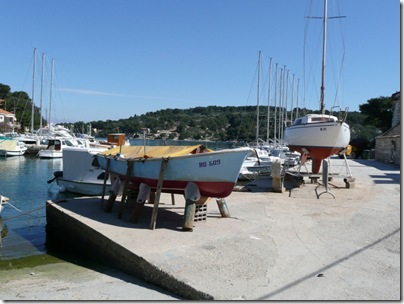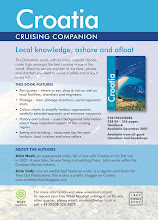
A few days ago we posted a review of Marinas In Croatia and pointed out that, although some marinas offer the ultimate in luxury, many town harbours are close to marinas in standard and usually half the price. However there are a few differences:
1. Town or village harbours are normally run by a small company that gets a concession from the government. They are not so easy to find on the web or book ahead. In the Croatia Cruising Companion we’ve done our best to give all the contact details, but sometimes that’s just a mobile phone number. In most cases you’ll find it’s better to turn up and find a space, though in the high season it’s worth getting there a little earlier.
2. Some local harbours are just too shallow for yachts and exclusively geared towards local fishing boats so check depths carefully. Again, in the Croatia Cruising Companion we’ve identified, as far as we can, the areas for yachts and those for local boats. However you’ll normally find someone ready to help you as soon as they spot you coming – normally the concession manager.
3. In all the town ports of any size you will find a source of electricity and water, normally in the form of a concrete bollard or two. In some cases though, these are at the shallow end. Some ports have pedestals for almost every berth but in a few smaller ports a degree of resourcefulness is required. In Kukljica on Ugljan island, our neighbours tapped into the electricity supply at the security office, even though there are pedestals on the inner pontoons; and there’s a small secluded bay up the Krka estuary, which for obvious reasons should remain nameless, where the locals are “wired” to the lamp-posts!
4. Check shelter carefully, (covered for each port in the Croatia Cruising Companion). Whilst you will find that nearly all marinas are sheltered from all weather conditions, the town harbours and moorings don’t always afford all round protection, particularly where the best mooring options for yachts are towards the outer end of the harbour, and sometimes on the outside of the breakwater.
5. In some municipal ports there are toilets and showers but this is the exception rather than the rule. In nearly all of them you will find lazy lines to tie up securely. You will normally be approached to pay your fees when you arrive and can expect to receive an invoice which will also include the nominal tourist tax charge for your stay. Also expect to hand over your passports briefly, and occasionally your other papers, so that the details can be taken. The overnight fee usually includes reasonable electricity and water where available. Out of season and in some smaller harbours, you may simply be expected to dine at the local restaurant in return for a berth.
6. As we suggest above, the fee is normally around half the amount you would pay at a marina though there are some exceptions where the standard of facilities are higher. The Brijuni islands in Istria, a favourite for superyachts, are one example; Lastovo is another.
On the whole, you get the best of both worlds in most town harbours – a comfortable berth at a reasonable price, but you still feel part of the local scene. Below are a few of our favourites:
Pučišća on Brač island – Pučišća seems to be oblivious to tourism though very welcoming to visitors. It’s a thriving town as a result of the white Brač stone it quarries and there’s evidence of this everywhere including statues and intricately carved stone lamp-posts. The long narrow bay has plenty of space and the depths for yachts, and electricity and water pedestals are generously scattered around it. There’s also a good supply of bars and restaurants and our only problem was the chiming of bells, from a number of churches, throughout the night.
Sali on Dugi Otok – Sali is picture postcard perfect at sunset with the pastel hues of the houses reflected on the water. Electricity and water are available and there’s a boatyard and engine repair facilities. No shortage of cafés and restaurants either and, as with Pučišća above, you can expect to find life all year round though its prosperity centres on fishing and fish processing.
Vrboska on Hvar – Vrboska is a sleepy village that calls itself Little Venice because of a number of bridges over the inlet. It also has an ACI marina (see Marinas In Croatia) but the enthusiastic harbour manager knows every trick in the book when it comes to diverting boats hovering around the marina entrance. Though Vrboska has a few bars and restaurants, for more facilities it’s a lovely walk of about an hour along the coast (and past some lovely houses) to Jelsa, a bigger and upcoming town with a ferry service to Split and Brač. Jelsa also has good berthing but it’s exposed to the Bora and the berths are beside a clutch of noisy restaurants so not the place for a quiet night!
Prvić Luka on Prvić Island – The Šibenik Archipelago has many hidden gems. Prvić Luka, our favourite, is a charming small town but has a newish boutique hotel, Maestral, that also act as a base for swimming holidays (Swimtrek). Berthing is inside the breakwater on lazylines and there are toilets and electricity and water available. If you fancy spending a little more time in this area, Zlarin and Krapanj island are well worth a visit and have good facilities. However note that Krapanj acts as a base for flotilla holidays and therefore the lovely Hotel Spongiola (which also provides the berthing facilities) can get a little raucous on changeover night.
Bol on Brač – These berths are not the most sheltered in all conditions but Bol is such a picturesque and compact town that it’s worth the trip. Electricity and water are available and if the weather conditions are not right you can always get a boat trip from Jelsa which lies opposite (see above). Bear in mind that the iconic Zlatni Rat beach, featured in most tourist literature photographs, and popular for wind surfing and other water sports, is a good walk away from the town centre. Also note that, despite its appearance on the photographs, its a pebble and not a sandy beach.
There are plenty of other great stops – Vis town on Vis island is one of the most popular, but those above are some of the less obvious. Today’s photo is of Rogač, the main ferry port on Šolta Island which provides a great illustration of how yachts and local boats co-exist in harmony on a quiet island. Šolta, the island, hides a number of gems and you can read much more about that on sister site Croatia Online. The link takes you to the last of four postings on this very special island just a short sail from Split.






